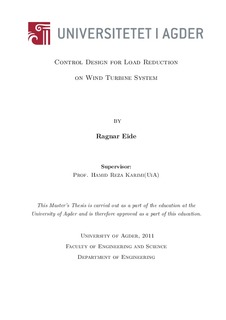Control design for load reduction on wind turbine system
Abstract
The wind power industry is currently the fastest growing renewable energy sector throughout the world. This
requires the technical expertise among engineers and researchers in the wind energy field to find technical
solutions which do not slow down this process. Since the technology is being developed at such a rapid rate,
the industry is facing many challenging problems, especially among systems and control researchers. To
ensure an economically competitive wind power production, the trend is to increase the turbine size while
at the same time minimize material usage. These factors result in increasing fatigue loads, which need to be
accounted for by a well defined control design. In this work, the basic theories of wind turbines are reviewed
firstly before proceeding with modeling, simulation, and controls implementation. What is suggested as a
means of load reduction is firstly a Disturbance Accommodating Control (DAC) approach. This is then
compared with the well-known Linear Quadratic Gaussian (LQG) controlling method. To improve the
robustness of the LQG, an additional Loop Transfer Recovery (LTR) procedure will be implemented and
compared with the results from the LQG. The main focus in this work is to use these modern control theories
to reduce the torque variations by using speed control with collective blade pitch adjustments. Simulations
show that better load reduction can be obtained by the dynamic compensator extracted from the LTR
procedure than with a regular LQG regulator.
Description
Masteroppgave i mekatronikk MAS500 2011 – Universitetet i Agder, Grimstad
